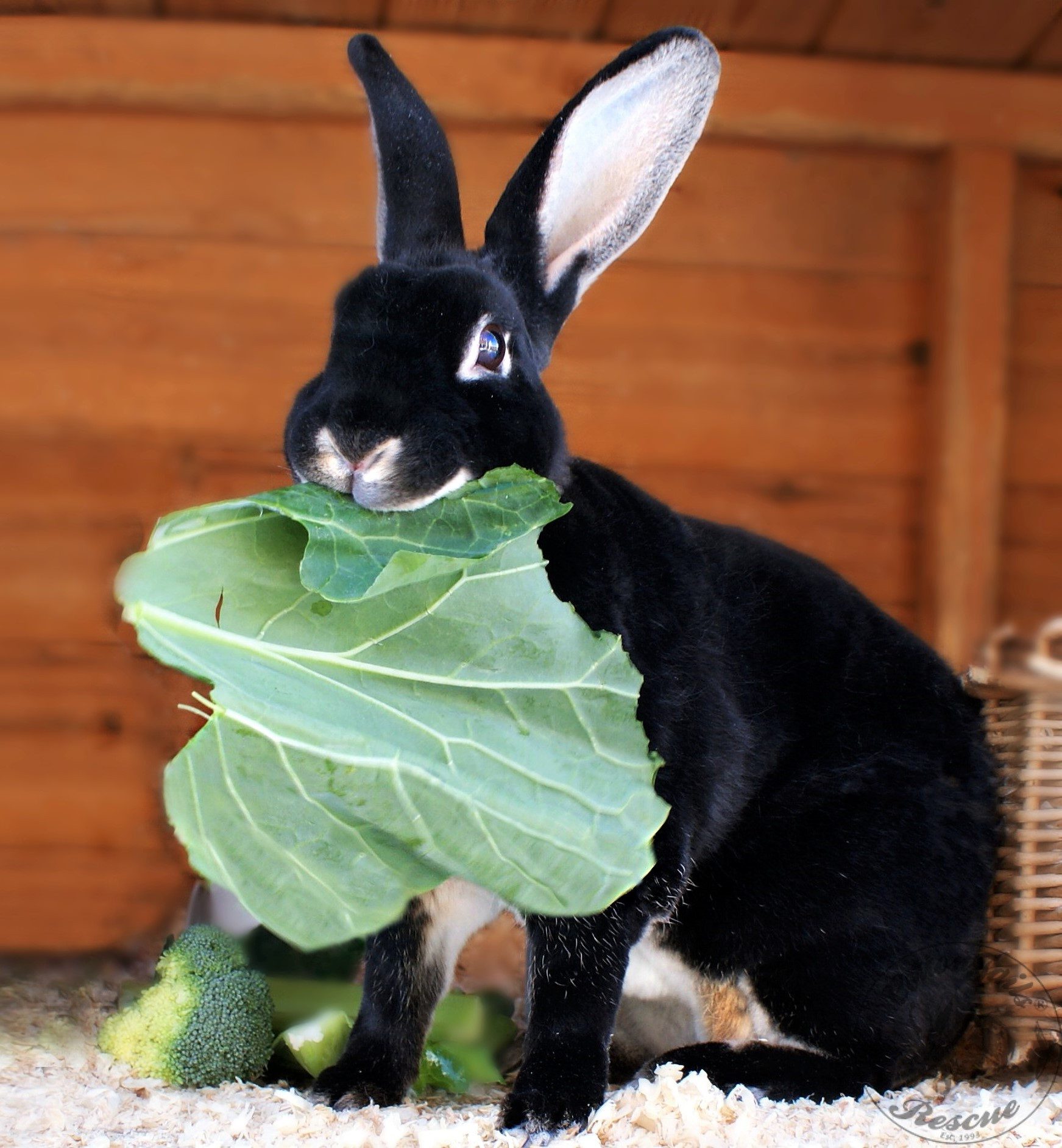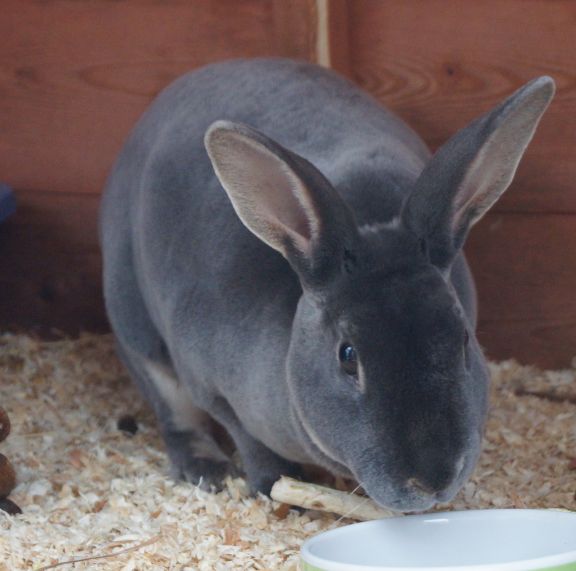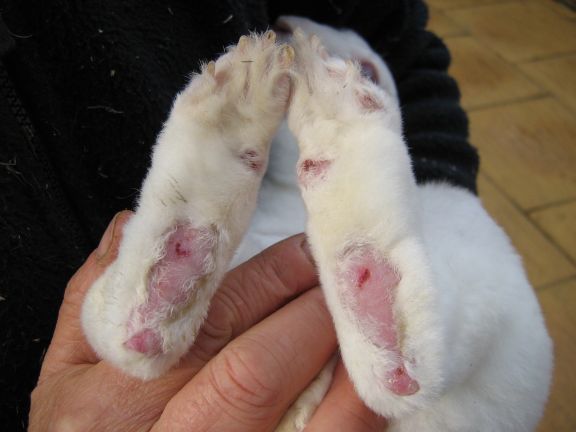Anyone who has stroked a Rex rabbit will know precisely what makes this breed unique – its luxurious deep-velvet fur. This quality endears the breed to pet owners and exhibitors alike, and perhaps controversially, even today in the UK, there are products made from Rex rabbit pelts, including, somewhat ironically, young children’s soft toy rabbits. Rabbits are not the only animal species with fabulous fur – Rex characteristics are also present in cats, rats, mice, hamsters and guinea pigs (2). However, the latter’s fur is not velvety soft but rather wiry and short.
Normal rabbit fur is made up of a short undercoat interspersed with longer guard hairs, these guard hairs forming a layer that covers and protects the soft underfur. The beautiful velvety springy fur of the Rex, however, is caused by a naturally occurring mutated gene resulting in the fur growing outward instead of lying flat, the guard hairs being shortened to the length of the undercoat with the result that the fur is all the same length, giving the soft plush texture. The gene is recessive and only exists if both parents pass it along (3). This mutated Rex gene can also cause the fur to curl in some areas, usually where the fur is a little longer, such as behind the ears.
Rex rabbits do not have normal whiskers but have shortened curly ones, or sometimes no whiskers at all, and they have retained the upright ears of their wild ancestors. Rex females have a dewlap under their chin, with both sexes having claws that are usually the same colour as their fur. (4).
So, how did this striking rabbit breed come about? It is well documented that the breed has been around for almost 200 years, being first discovered in France in 1919, but this is where the agreement ends as there are divided opinions regarding who founded the breed and where. One version tells of the breed being found quite by chance, with initially one and then another odd-looking wild rabbit being found (5). Another states that two rabbits with a “rexed” coat were discovered amongst barn rabbits but were in a sorry state, almost without fur and misshapen.
Both versions agree that it was only the foresight of the local village priest Abbot l’Abbe Gillet who recognised the potential of such a rabbit that the Rex breed was developed at all (5, 6). These rabbits that founded the Rex breed were found in a village in the southwest of France, although accounts vary as to the exact location – some quote the village of Luche-Pringe (7), others the nearby village of Coulonge (5). Not surprisingly, the first attempts to develop the breed resulted in an agouti version of the Rex, agouti being the wild rabbit colour, and such was the appearance of the fur of these rabbits they were named “Castor” as their pelts resembled the fur of a beaver – “castor” meaning “beaver” in French.
The story goes that the priest was so taken with his attempts at developing the breed that he declared them the “King’s rabbits”, “Rex” meaning “King” in French, hence the “Castorrex”, as a breed, was born (5). The “castor” part of the name was dropped after some years, leaving the breed to be called simply the Rex. It was in 1924 that the Rex rabbit was first introduced to the public at a Paris International Rabbit Show. It immediately caught the imagination of exhibitors and commercial fur and meat breeders alike, with the breed being imported into the USA shortly after.
After much development by introducing other rabbit breeds into the line, the problems with thin fur due to interbreeding were rectified, resulting in the beautiful fur we know today (8). The Rex breed was officially recognised as a standard breed in 1925 in many parts of Europe (4).
Not content with the Rex as it was, various attempts were made to vary its size and colour, resulting in the development of numerous varieties and the emergence of the mini Rex as a breed. After the mini Rex was accepted, some adopted the term “standard Rex” to refer to the original Rex rabbit (9). The mini Rex Rabbit is appropriately named as it resembles a miniature version of the Rex (standard) rabbit. It was developed by a rabbit breeder in Texas in 1984 from imported Rex rabbits from Holland crossed with Netherland dwarfs to reduce the size. The American Breeders Rabbit Association officially recognised the mini Rex in 1988 (10), becoming one of the most popular rabbit breeds in the USA. It is increasing in popularity here in the UK.
The Rex is considered a medium to large rabbit, the average weight being 2.7 – 4.5 kg. In comparison, the mini Rex is a smaller breed, with an average weight of 1.4 – 1.8kgs. Both breeds are considered intelligent, but this varies between individuals, just like with any rabbit breed. They come in a variety of colours, including black, blue, castor (chestnut), chinchilla, amber (cinnamon or chocolate agouti), chocolate, lilac, otter, lynx, opal, sable, seal, and white (11). Further development of the Rex rabbit resulted in the somewhat rare Astrex, Opossum, and the Velveteen lop (11, 12, 13). The Astrex rabbits have tightly curled fur and come in a variety of self (single) colours, whilst the Opossum is similar to the Astrex, but its fur is tipped with white, giving it a stunning silvering appearance.
The Velveteen Lop has a story all on its own! In 1922, in the USA, Margery Williams wrote a children’s book, “The Velveteen Rabbit” with delightful illustrations by William Nicholson (14), telling the story of a stuffed toy rabbit and his desire to become real through the love of his owner, a little boy. This story touched the hearts of many children and is still enjoyed today, so when the Rex breed became a reality, some rabbit breeders decided to try to create such a breed and settled on the Velveteen Lop. It was 1994 before the first litter of Velveteen Lops was born through selective breeding, which has continued until today. The breed looks like a smaller version of the English lop (the very original lop breed to be developed) with huge long ears and velvet fur like the Rex (15). The breed has finally been officially recognised.
Sadly, you cannot expect to manipulate any animal by selective breeding without encountering problems, which is the case with the Rex. The texture of their coat means that they cannot be groomed in the usual way, as brushing can damage the texture of the coat, so quick grooming with a slightly damp hand or soft cloth is usually all that is required. Like most rabbits, the Rex does not like extremes of temperature, but they tolerate cold better than extreme heat, which is not surprising considering their fur (11). The curly whiskers can cause problems, too, and need to be checked regularly to ensure they are not growing into the rabbit’s eyes or nose, and any that are getting too long in this way need to be trimmed.
However, the Rex’s increased risk of ulcerative pododermatitis or sore feet is more severe than this. Rex rabbits have less fur on their feet compared to breeds with normal fur, which can result in sores on the soles of the hind feet and sometimes sore front feet. Calluses on the hind feet are relatively common in the Rex. Still, when the skin ulcerates and becomes infected, this is very serious indeed, and veterinary treatment needs to be started immediately to prevent possible amputation of toes or worse due to the bones and bone marrow in the feet becoming inflamed (16).
Rabbits with sore feet sit differently from other rabbits, with their weight rocked forward onto their front paws, or they sit with their hind feet sticking up off the floor. They are also often reluctant to move around much due to the pain and discomfort this condition can bring. Some will appear to keep shifting their weight from one side to another to get comfortable, and if all four paws are affected, they go up on their toes when walking or hopping around to put the least pressure on the sore areas. If the front feet are affected as well, the rabbit will often shake its front paws and appear to bite them, but this should not be confused with the shaking of the front paws that usually happens just before a rabbit washes its face (17).
Prevention is far better than cure, so ensuring the rabbit does not get overweight, keeping the area clean, and giving deep, soft bedding such as barley straw or straw matting for the rabbit to sit on will undoubtedly help (18). Certain conditions, such as E. cuniculi or other illnesses that cause hind-end semi-paralysis, can also predispose any rabbit to this condition. Still, breeds like the Rex and giants like the Flemish will always be at higher risk. Without question, a rex rabbit should never be kept on a wire mesh floor, and that is also true of runs with wire mesh bases, as this will inevitably cause problems with the feet.
Despite pododermatitis, owning a Rex rabbit is a true joy, and they are no more prone to general health issues (such as gut stasis) than any other breed. If kept correctly, they should have a problem-free, long, and healthy life and give great pleasure, so let’s hear it for the Rex!
Bibliography – SInce the writing of this article, many of the source url’s are no longer working, so I have listed them here but have removed the direct link capability.
- no longer required
- https://www.bunnyhugga.com/a-to-z/breeds/rex.html
- https://nationalrexrc.org/varieties.htm
- https://rexrabbitsusa.com/rex-rabbit/
- https://www.pets4homes.co.uk/breeds/rabbits/rex/
- https://www.justrabbits.com/rex-rabbit.html#gs.BTsy8NQ
- https://www.rabbitmatters.com/mini-rex.html
- https://rabbitbreeders.us/rex-rabbits
- https://rexrabbitsusa.com/rex-rabbit/
- https://en.wikipedia.org/wiki/Rex_mutation
- https://www.raising-rabbits.com/rex-rabbit.html#sthash.Qrb6TONU.dpuf
- https://www.pet-owners.co.uk/Pet-Guides/Rabbits/Rabbit-Breeds/Rex-Rabbit.aspx
- https://www.thebrc.org/standards.htm
- https://digital.library.upenn.edu/women/williams/rabbit/rabbit.html
- https://www.sleepysouthhollandlops.com/velveteen_lops.html
- https://www.vetmed.wsu.edu/ClientED/bunny.aspx




